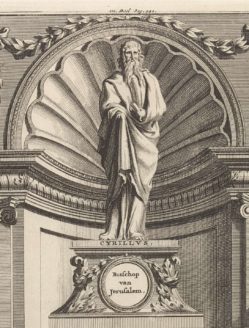
The motto of my home state of North Carolina is Esse quam videri, Latin for “to be, rather than to seem.” It is a motto that speaks of integrity, reminding us that essence is more important than appearance. We get that wrong to our detriment.
The discrepancy between appearance and reality is what lies at the heart of Jesus’ criticisms of the Pharisees. “All their works are performed to be seen,” he says. “They widen their phylacteries and lengthen their tassels” (Mt 23:5). Phylacteries and tassels may not be familiar to many modern Christian readers of the gospel. They are outward signs of devotion to the Law of Moses which are still in use in many Jewish communities.
Phylacteries are small wooden boxes worn strapped to the arm and forehead that contain within them passages from the Torah. It is a literal way of observing the instruction in Deuteronomy 6:8 to bind the commands of God on your hand and between your eyes. The tassels Jesus refers to are those worn tied to the four corners of the tzitzit (a traditional undergarment worn by Jewish men), the cords of which represent the Mosaic Law (see Numbers 15:37-41).
Both the phylacteries and the tassels of the tzitzit are meant to serve as physical reminders for the wearer to remain faithful to the covenant. So what’s the problem? Jesus’ criticism was not because the Pharisees were wearing these objects, but because they were wearing them primarily for show. They were widening their phylacteries and lengthening their tassels not because doing so made them any more observant of God’s law, but so that others would see them. They had become more concerned with the appearance of being holy than with holiness itself. Jesus similarly criticizes those who pray, fast, or give alms for the sake of appearance in Matthew chapter six.
There is a lesson here for modern Catholics. Christians may not wear phylacteries or tzitzit like the Pharisees, but we certainly have other outward signs of devotion. In An Introduction to the Devout Life, St. Francis de Sales warns against mistaking these external signs of devotion for devotion itself, which he says is nothing less than true love of God.
The external signs of Catholic devotion are too numerous to catalog, but we can easily think of a few: hanging a rosary from the rear-view mirror of your car, or always having one clutched in your hand at Mass; wearing a mantilla, or a saint’s medal or other devotional jewelry; wearing a scapular; displaying a bumper sticker or wearing a t-shirt with a Bible verse or quote from a saint; decorating your home with religious art.
None of these things are bad. They can, in fact, be quite helpful in encouraging us to keep focused on our faith which is the very point in using them. These external shows of devotion are means to an end. They are meant as tools to help us grow in internal devotion by fostering the love of God in our heart. But if we conflate these devotional aids with devotion itself, we’ve missed the point. And if we are drawn to them because they give us the appearance of being devout, then we are using them for the wrong reason.
The rear-view mirror rosary should remind us to pray when we get behind the wheel. It should not be used as a good-luck charm and certainly not to signal that we are holier than other drivers who prefer fuzzy dice. Even a laudable practice such as arriving early to pray before Mass can fall into this category if we are more concerned that others see us praying than we are with prayer itself.
Jesus’ condemnation of the Pharisees is not a call for us to discard our rosaries and other religious paraphernalia. He doesn’t condemn them for their phylacteries and tassels, but for their hypocrisy. His admonition should serve as an occasion for us to examine our conscience regarding our own devotional practices. Does the outward appearance we project correspond to the inner disposition of our hearts (or at least where we are striving for them to be)? If so, then all is well. But if there is a discrepancy between our interior life and our exterior show, that is something we must work on.
More than He wants our external piety, God desires our hearts. The many devotional aids and practices we are blessed to have at our disposal in the Catholic tradition are meant to help us learn to give our hearts to God more fully and more freely. Let’s make use of them as they are intended, mindful of their purpose, not merely going through the motions of devotion but allowing these practices to form us into people truly in love with the Lord.
Photo by triocean on Shutterstock




